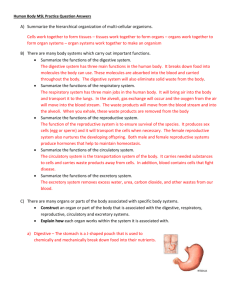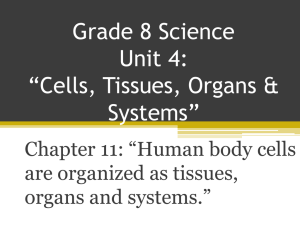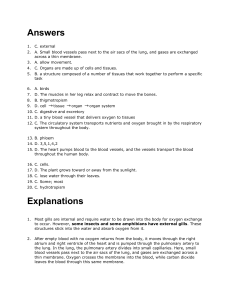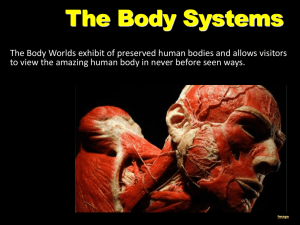Human Body Systems
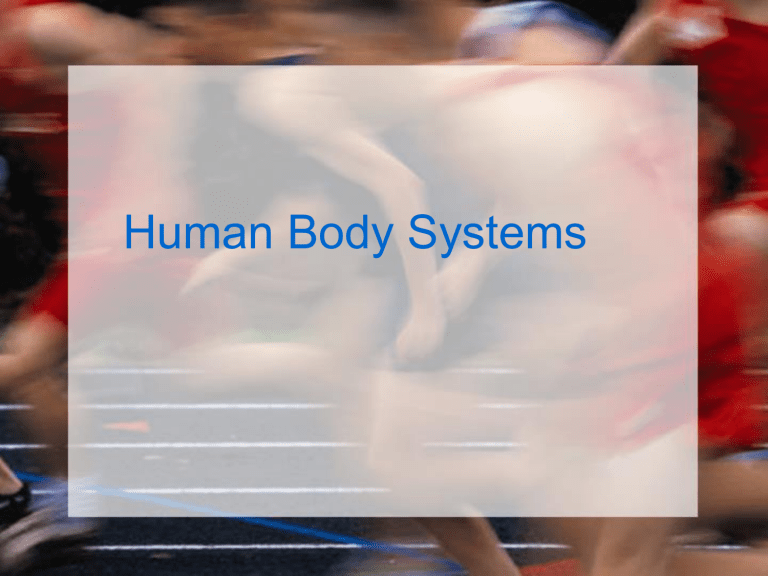
Human Body Systems
Monday, April 30
WARM-UP: Do CST Practice Problems (1-10)
DO NOT WRITE ON THE TEST! Put your answers on the blue paper.
• Turn in your poster“Do Your Part to be
Earth Smart”
• HW: Read 35-2 and do the review
• Notebooks due: Friday, May 4 th
Human Body Systems
Section 35 –1
This section describes human organ systems and explains how the body maintains homeostasis.
Warm-Up: What are the 11 organ systems of the human body?
Integumentary (skin), nervous, muscular, digestive, skeletal, reproductive, endocrine, respiratory, circulatory
(cardiovascular), excretory/urinary, immune/lymphatic
Immune
Tuesday, May 1
st
Warm-Up: What is Physiology?
Physiology – the study of the structure and function of the human body
HW: Read 35-2 and do the review
Notebooks due Friday May 4 th
Use Ch. 35-1 to do the following in your notebook: (paste into notebook)
• Describe the levels of organization in the body
(cells, tissues, organs, organ systems) and give an example of each (p. 891)
• Write down and draw each of the 11 organ systems and their functions. (p. 892-893)
• Explain the difference between the four types of tissues. (p. 894)
• Define homeostasis. (p. 895)
Levels of Organization
Cells
Tissues
Organs
Levels of Organization of the Body
• Specialized Cells have a particular function.
• Tissues are a group of specialized cells that perform a single function.
• Organs are a group of tissues that work together to perform a complex function.
• Organ Systems are a group of organs that work together to perform closely related functions.
Nervous
System
Function
• Recognizes and coordinates the body’s response to changes in its internal and external environments using the brain and nerves
Integumentary
System Function
• Serves as a barrier against infection and injury; helps to regulate body temperature; provides protection against UV radiation from sun.
Respiratory
System
Function
• Provides O
2 needed for cellular respiration and removes CO body.
2 from
Digestive
System
Function
• Converts food into simpler molecules that can be absorbed into bloodstream and then used by cells of body; eliminates waste.
Excretory System Function
• Eliminates waste products from body using kidneys, bladder and urine to maintain homeostasis.
Skeletal
System
Function
• Supports the body; protects internal organs; allows movement; stores minerals; provides site for blood cell formation.
Muscular System
Function
• Works with skeletal system to produce voluntary movement
( skeletal muscle ); helps circulate blood ( cardiac muscle ) and moves food through digestive system
( smooth muscle ).
Circulatory
System Function
• Brings O
2
, nutrients and hormones to cells through the blood; fights infection; removes cell waste through the blood; helps regulate body temperature.
Endocrine System Function
• Uses hormones to control growth, development and metabolism; maintains homeostasis.
Reproductive
System Function
• Produces reproductive cells; in females, nurtures and protects developing embryo.
Immune/Lymphatic
System Function
• Protects the body from disease; collects fluid lost from blood vessels and returns the fluid to the circulatory system.
Explain the difference between the four types of tissues.
Epithelial tissue includes glands and tissues that cover interior and exterior body surfaces.
Explain the difference between the four types of tissues.
Connective tissue provides support for the body, insulates and connects its parts.
Examples: Fat, cartilage, bones, tendons, and blood.
Explain the difference between the four types of tissues.
Nervous tissue transmits nerve impulses throughout the body.
Explain the difference between the four types of tissues.
Muscle tissue enables movement of body and its structures by muscle contraction. 3 types: skeletal, cardiac and smooth
Homeostasis: the process by which organisms keep their internal conditions relatively stable; threatened by changes in the environment.
Ex: sweating, panting, shivering, osmosis, dilation of pupils
Endothermy (being warm-blooded)
• Endothermy enables the body to maintain homeostasis at all times, regardless of the temperature outside the body.
Nervous system
Coordinates the body’s response to changes in its internal and external environments
Stores mineral reserves and provides a site for blood cell formation Skeletal system
Integumentary system
Endocrine system
Lymphatic/Immune systems
Serves as a barrier against infection and injury
Eliminates wastes and maintains homeostasis
Helps protect body from disease.
Muscular system
Helps produce voluntary movement, circulate blood, and move food
Reproductive system Produces reproductive cells
Respiratory system Provides oxygen and removes carbon dioxide
Excretory system Eliminates wastes and maintains homeostasis
Circulatory system
Brings materials to cells, fights infection, and helps to regulate body temperature
Digestive system Converts food so it can be used by cells




